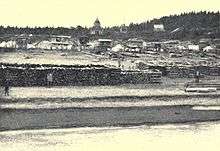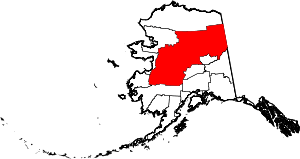Nulato, Alaska
Nulato (/nuːˈlætoʊ/; Noolaaghe Doh /nuːlaːɣə tɔːχ/ "chum salmon fish camp" in Koyukon; Russian: Нулато) is a city in Yukon-Koyukuk Census Area, Alaska, United States. At the 2010 census the population was 264.
Nulato Noolaaghe Doh | |
|---|---|
City | |
 Nulato Location in Alaska | |
| Coordinates: 64°43′48″N 158°6′51″W | |
| Country | United States |
| State | Alaska |
| Census Area | Yukon-Koyukuk |
| Incorporated | April 22, 1963[1] |
| Government | |
| • Mayor | Maurice McGinty[2] |
| • State senator | Donald Olson (D) |
| • State rep. | Neal Foster (D) |
| Area | |
| • Total | 43.79 sq mi (113.40 km2) |
| • Land | 41.09 sq mi (106.43 km2) |
| • Water | 2.69 sq mi (6.98 km2) |
| Elevation | 115 ft (35 m) |
| Population | |
| • Total | 264 |
| • Estimate (2019)[5] | 243 |
| • Density | 5.91/sq mi (2.28/km2) |
| Time zone | UTC-9 (Alaska (AKST)) |
| • Summer (DST) | UTC-8 (AKDT) |
| ZIP codes | 99765 |
| Area code | 907 |
| FIPS code | 02-56350 |
| GNIS feature ID | 1407321 |
History

Nulato was a location for trade between the Koyukon people and Inupiat people of the Kobuk River area before the arrival of Europeans.
In 1838, the Russian explorer Malakov established a trading post in Nulato.[6]
The Kokukuk River people massacred a large part of the population of Nulato on February 16, 1851, during the Athapaskan uprising.[6]
After the Alaska Purchase, a United States military telegraph line was constructed along the north side of the Yukon River. The gold rush along the Yukon River that began in 1884 brought many new diseases to the area and many people died. Our Lady of Snows Roman Catholic mission and school were opened in 1887 and many people moved to Nulato to be near the school. A measles epidemic and food shortages during 1900 reduced the population of the area by one-third. 1900 was also the peak year for steamboat travel on the Yukon River, with 46 boats in operation. That summer, two boats per day stopped at Nulato to purchase firewood.
Gold prospectors left the Yukon River area for Fairbanks and Nome in 1906. Lead mining began around neighboring Galena in 1919.
Nulato incorporated as a city in 1963. In 1981, housing was built at a new townsite 3 km (1.9 mi) from present Nulato.
Geography
Nulato is located at 64°43′48″N 158°6′51″W (64.730011, -158.114101).[7]
Nulato is on the west bank of the Yukon River, 53 km (33 mi) west of Galena, in the Nulato Hills. It is across the Yukon River from the Innoko National Wildlife Refuge.The area experiences a cold, continental climate with extreme temperature differences. Temperatures range from -70F to 80F. Average precipitation is 15.6 inches, with 74 inches of snowfall annually.
According to the United States Census Bureau, the city has a total area of 44.8 square miles (116 km2), of which, 42.7 square miles (111 km2) of it is land and 2.0 square miles (5.2 km2) of it (4.56%) is water.
Transportation
The town is serviced by Nulato Airport which has regularly scheduled flights to Galena, Kaltag[8] and Koyukuk.
Education
The Yukon–Koyukuk School District operates the Andrew K. Demoski School in Nulato.[9]
Culture
Every other year, the people gather in Nulato to attend the week-long Stick Dance.[6] It is celebrated on the years that it is not held in Kaltag, Alaska. People from all over the Athabascan region gather in the small village to attend the sacred dance that is done to celebrate the lives of lost loved ones and to appreciate the people that helped the family through the mourning process. This ceremony was started by a couple that lost their family in a tragic accident centuries ago. Friday night of the stick dance is the largest and most powerful night of that week, on this particular night the attendees sing 14 sacred songs and dance this particular dance is called in the Athabascan language Meyegha Doh Sealyihe (the dance before the stick dance) after this dance they put a decorated stick up in the center of the gathering place and chant while going around the stick (chants- Heeyo Heeyo Heeyo Hey Heeyo Heeyo Heeyo Hey). Nulato residents are predominantly Koyukon Athabascan with trapping and subsistence lifestyle.
Demographics
| Historical population | |||
|---|---|---|---|
| Census | Pop. | %± | |
| 1890 | 118 | — | |
| 1900 | 281 | 138.1% | |
| 1910 | 230 | −18.1% | |
| 1920 | 258 | 12.2% | |
| 1930 | 204 | −20.9% | |
| 1940 | 113 | −44.6% | |
| 1950 | 176 | 55.8% | |
| 1960 | 283 | 60.8% | |
| 1970 | 308 | 8.8% | |
| 1980 | 350 | 13.6% | |
| 1990 | 359 | 2.6% | |
| 2000 | 336 | −6.4% | |
| 2010 | 264 | −21.4% | |
| Est. 2019 | 243 | [5] | −8.0% |
| U.S. Decennial Census[10] | |||
Nulato residents are predominantly Koyukon, an Alaska Native Athabaskan people of the Athabaskan-speaking ethnolinguistic group.
As of the census[11] of 2000, there were 336 people, 91 households, and 71 families residing in the city. The population density was 7.9 people per square mile (3.0/km²). There were 119 housing units at an average density of 2.8 per square mile (1.1/km²). The racial makeup of the city was 5.06% White, 92.86% Native American, 0.60% from other races, and 1.49% from two or more races. 0.60% of the population were Hispanic or Latino of any race.
There were 91 households out of which 51.6% had children under the age of 18 living with them, 36.3% were married couples living together, 27.5% had a female householder with no husband present, and 20.9% were non-families. 14.3% of all households were made up of individuals and 1.1% had someone living alone who was 65 years of age or older. The average household size was 3.69 and the average family size was 4.13.
In the city, the age distribution of the population shows 41.7% under the age of 18, 10.7% from 18 to 24, 25.0% from 25 to 44, 15.5% from 45 to 64, and 7.1% who were 65 years of age or older. The median age was 23 years. For every 100 females, there were 97.6 males. For every 100 females age 18 and over, there were 102.1 males.
The median income for a household in the city was $25,114, and the median income for a family was $26,944. Males had a median income of $24,375 versus $25,313 for females. The per capita income for the city was $8,966. About 16.7% of families and 18.1% of the population were below the poverty line, including 20.0% of those under age 18 and 4.5% of those age 65 or over.
Koyukon Athabascans
The Koyukon Athabascans had seasonal camps in this area and moved when the wild game migrated. There were 12 summer fish camps located on the Yukon River between the Koyukuk River and the Nowitna River.
Notable residents
Koyukon Athabascan author Poldine Carlo was born in Nulato.
References
- "Directory of Borough and City Officials 1974". Alaska Local Government. Juneau: Alaska Department of Community and Regional Affairs. XIII (2): 61. January 1974.
- 2015 Alaska Municipal Officials Directory. Juneau: Alaska Municipal League. 2015. p. 117.
- "2019 U.S. Gazetteer Files". United States Census Bureau. Retrieved June 30, 2020.
- "Annual Estimates of the Population for Incorporated Places in Alaska". United States Census Bureau. 2008-07-10. Archived from the original on 2008-09-12. Retrieved 2008-07-14.
- "Population and Housing Unit Estimates". United States Census Bureau. May 24, 2020. Retrieved May 27, 2020.
- National Geographic, The Making of America, Alaska, (map), Wilbur E. Garrett, Editor, John B. Garver Jr., Chief Cartographer, John F. Shupe, Associate Chief, January 1984
- "US Gazetteer files: 2010, 2000, and 1990". United States Census Bureau. 2011-02-12. Retrieved 2011-04-23.
- "2007 Timetable" (PDF). Frontier Flying Service. Archived from the original (PDF) on July 30, 2007. Retrieved August 31, 2007.
- "Andrew K. Demoski School, Nulato." Yukon–Koyukuk School District. Retrieved on June 16, 2016.
- "Census of Population and Housing". Census.gov. Retrieved June 4, 2015.
- "U.S. Census website". United States Census Bureau. Retrieved 2008-01-31.
